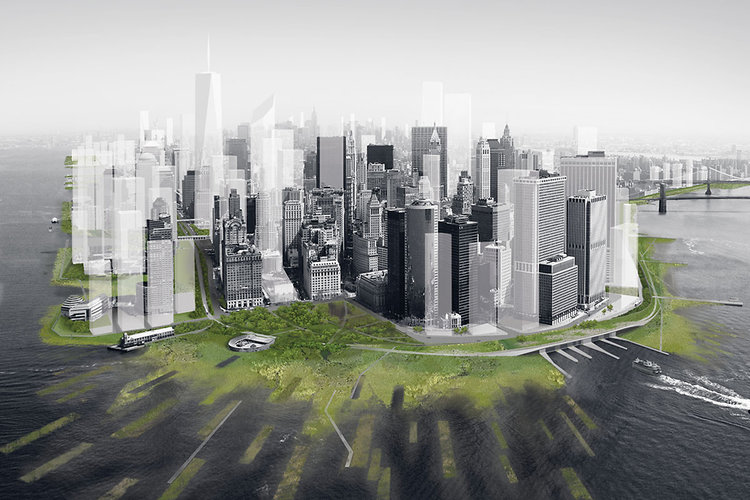
Wetlands to provide a storm surge buffer for New York City. Image from Architecture Research Office
Fast Company: A Plan To Hurricane-Proof New York, With A Ring Of Wetlands
In the wake of Hurricane Sandy, there have been a flurry of ideas on how to deal with the prospect that storms of such magnitude may no longer be once-in-a-lifetime events but the most visible manifestation–if you’re not a polar bear–of the havoc wreaked by climate change.
Seawalls. Levees. The kinds of things the Army Corps of Engineers typically builds to protect low-lying places like New Orleans just aren’t feasible for a place like Manhattan, says Stephen Cassell, the cofounder of New York’s Architectural Research Office. “It’s hard to predict how bad climate change will be,” Cassell says, noting that Sandy’s devastating surge was nearly 14 feet, which wasn’t even the worst-case scenario. “What if we build a barrier and the surge goes beyond that?”
Yes Providence, what if the storm surge is higher than our storm surge barrier?
New York Post: Growing NY through smarter taxes
How might two-tiered taxation work? In New York, land and improvements in residential areas are subject to an 18.6 percent property tax.Thus, land with a taxable value of $10,000 would be taxed $1,860, and improvements with a similar taxable value of $10,000 would owe another $1,860, a total of $3,720. Under a two-tier system, the tax rate for land could jump by, say, 50 percent, while the rate for improvement could be halved.In that case, the owner would pay $2,790 in land taxes and $930 for improvements — keeping the total to $3,720.
But here’s the payoff: The owner’s tax bill under that scheme would climb another $2,790 if he purchased a second lot with a taxable value of $10,000 — but by only $930 if he used that money toward building.Thus, hoarding would be discouraged; development encouraged.
The two-tier property tax has a proven record of success. In 1979, Pittsburgh began taxing land at a rate six times higher than improvements. In the ensuing decade, building permits increased by 70.4 percent.
Via: Nesi’s Notes
And speaking of Pittsburgh…
Pittsburgh Post-Gazette: Upheaval and losses hurt, but Downtown Pittsburgh emerged from economic turmoil renewed
The collapse of the steel industry soon caused ripple effects throughout the local economy. Gulf merged with Chevron and sold its Downtown headquarters. Climate-controlled shopping malls in Monroeville and later Ross lured shoppers from Downtown to the suburbs, where the parking was free. Some businesses headed the same way.
…the biggest change has been on the residential side. Thirty years ago, when the Central Business District was the hub of retail and industry, few envisioned a time when it would become a housing enclave.
As more people move into downtowns, businesses seeking to accommodate their employees will follow, he said. That in turn will bring more retail — in essence, reversing the flight that occurred decades ago.
The Atlantic Cities: Public Funding for Stadiums Jumps the Shark in Miami
Cities readers know that one of my biggest economic development peeves — right alongside government-backed casinos — is the gargantuan public giveaway to professional sports stadiums. And according to the Brookings Institution’s Adie Tomer and Siddharth Kulkarni, writing earlier this month in the Sun Sentinel, the outrageous, over-the-top deal for the new Miami Marlins stadium should once and for all end the “era of publicly funded stadiums.”
The Boston Globe: Battery Ventures plans move to Boston
Most recent Massachusetts Institute of Technology or Harvard University graduates who are starting an Internet company aren’t hanging around Waltham. “They don’t have the social network out in the suburbs that would lead them to any of the venture firms on 128,” Webb said.
“The heart and soul of the start-up ecosystem is focused on Cambridge, but there’s a new energy in Boston,” said Roy Hirshland, president of T3 Advisors, a real estate advisory firm in Waltham that worked with Battery Ventures.
In fact, the South Boston Waterfront is undergoing a rapid transformation with new office towers, condos, and lab space planned for the waterfront neighborhood renamed the Innovation District by Menino to attract high-tech tenants. Recently the car sharing company Zipcar Inc. and the growing software company LogMeIn Inc. inked deals to move there.
If companies are leaving the Route 128 belt for more urban destination, can’t we entice a few to Providence and our (so-called) Knowledge District?




Some companies from the Route 128 belt could possibly be enticed to Providence, but mass transit would need improvement (high frequency downtown streetcar or BRT) and more apartments should be built downtown. There’s now a critical mass of people living Downcity, but more would help. Why Cambridge is such a draw, besides the schools and quality of life, is mass transit, hence the current expansion to Boston. Though Providence’s MBTA service is a plus. What kinds of companies are being formed in Cambridge/Boston or are moving in from Route 128? Working off of Providence’s academic and startup company strengths would likely inform what type of companies might consider relocating to the city from the 128 area.
Jef, I know that you qualified the “Knowledge District” as (so-called). It’s such an asinine public relations name that’s already dated. Using Jewelry District or I-195 land or something else or nothing would be preferable. Just seeing “Knowledge District” in writing encourages people to accept it and use it. Boston’s use of “Innovation District” is equally stupid.
The two-tiered tax would be as close as anything could be to a magic bullet for what ails this town. I would stipulate that the following “improvements” be subject to the higher tax rate: Asphalt and little parking-attendant shacks.
Amen to the rant about “Knowledge District.” May that name be even more pointedly ignored by normal people than “Avenue of the Americas.”